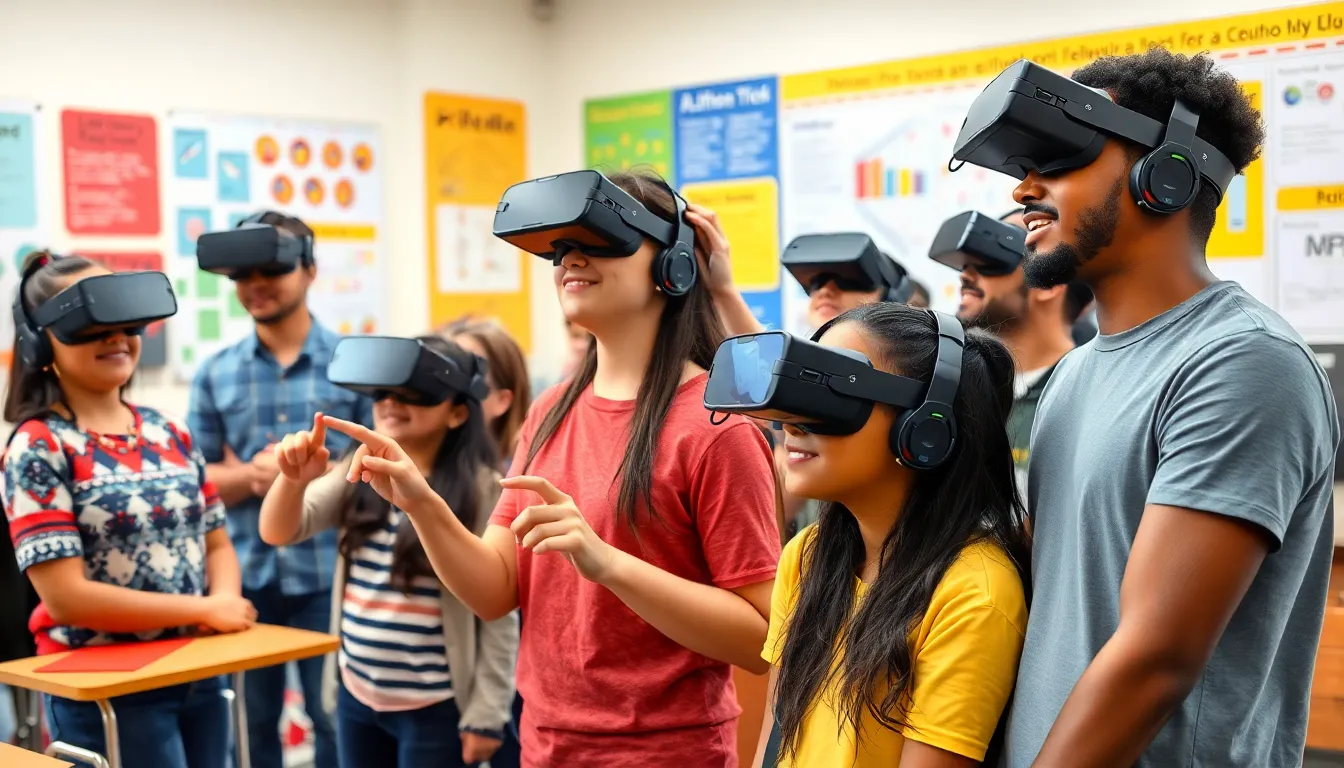In a world where smartphones are practically an extension of our hands, it’s no surprise that education is getting a tech makeover. Emerging technologies are transforming classrooms into futuristic learning hubs, where students can explore, create, and collaborate like never before. Imagine a classroom where virtual reality takes students on field trips to ancient civilizations without leaving their desks. Sounds like a sci-fi movie, right?
Table of Contents
ToggleOverview of Emerging Technologies in Education
Emerging technologies in education reshape traditional learning environments, introducing innovative methods and tools that enhance engagement. Virtual reality (VR) allows students to embark on immersive journeys, exploring historical sites without leaving their classrooms. Augmented reality (AR) supplements this by adding digital layers to physical objects, creating interactive experiences that deepen understanding.
Artificial intelligence (AI) tailors educational content to individual student needs, improving personalized learning pathways. Adaptive learning platforms leverage AI algorithms, adjusting lesson difficulty based on real-time student performance data. This ensures every student receives support relevant to their unique learning pace.
Gamification techniques integrate game elements into educational content, fostering motivation and competition. Students engage with subjects through interactive quizzes, leaderboards, and challenges, making learning fun and stimulating. These strategies not only promote knowledge retention but also build essential skills such as teamwork and problem-solving.
Cloud computing facilitates resource sharing and collaboration, providing access to educational materials from anywhere. Students and teachers can use cloud-based platforms to collaborate on projects, share files, and communicate efficiently. This accessibility breaks down barriers and enhances the learning experience, making it more inclusive.
Data analytics in education allows institutions to track student performance and identify trends. Schools employ data-driven insights to implement effective teaching strategies, enhancing overall educational outcomes. In combination, these emerging technologies create a comprehensive support system, preparing students for future challenges.
Types of Emerging Technologies

Emerging technologies significantly impact education, transforming how students learn and engage with content. Below are key types of technologies shaping modern learning environments.
Artificial Intelligence in Education
Artificial intelligence (AI) revolutionizes personalized learning. Adaptive learning platforms utilize AI to tailor educational content based on individual student performance, ensuring lessons match their unique needs. AI-powered tools can grade assignments efficiently, providing immediate feedback to students. By analyzing data, AI identifies learning patterns, assisting educators in adjusting teaching strategies accordingly. Institutions benefit from enhanced administrative efficiency, freeing up resources for student support.
Virtual and Augmented Reality
Virtual reality (VR) and augmented reality (AR) create immersive learning experiences. Educators harness VR to transport students to historical landmarks and scientific environments, enhancing engagement and understanding. AR layers digital information onto physical objects, encouraging interactive exploration of subjects. Both technologies foster collaboration and experiential learning, allowing students to engage actively with content. They also contribute to skill development in areas like critical thinking and problem-solving, preparing students for real-world applications.
Benefits of Emerging Technologies
Emerging technologies transform educational landscapes, providing innovative solutions that enhance learning outcomes. These advancements foster enriched interactions and cater to diverse student needs.
Enhancing Learning Experiences
New technologies, such as virtual reality and augmented reality, redefine classroom engagements. Educators use virtual field trips to transport students to historical sites, turning lessons into memorable adventures. Learning becomes more interactive with AR, which integrates digital content with real-world environments. These tools stimulate curiosity and encourage collaborative projects, making learning both enjoyable and impactful. Students thrive as they interact with complex concepts in practical settings, developing essential skills for future challenges.
Personalized Learning Environments
Artificial intelligence plays a crucial role in tailoring educational experiences to individual learning styles. Adaptive learning platforms analyze student performance, creating customized lesson plans that cater to unique needs. Immediate feedback empowers students to learn at their own pace and engage with content more effectively. Additionally, data-driven assessments inform teachers, enabling them to adjust instruction based on real-time analytics. This personalized approach fosters a supportive learning environment, enhancing student motivation and achievement.
Challenges and Considerations
Emerging technologies in education present numerous challenges that institutions must navigate. Effective implementation requires awareness of obstacles.
Implementation Barriers
Resistance to change often hinders adoption of new technologies in educational settings. Often, educators face limited training opportunities that impede their ability to utilize advanced tools. Financial constraints can also restrict access to necessary resources. Moreover, outdated infrastructure may not support the latest technologies effectively. Schools must prioritize investing in training and infrastructure to mitigate these barriers. Addressing these challenges is crucial for successful integration of emerging educational technologies.
Privacy and Security Concerns
Privacy and security issues represent significant risks related to emerging educational technologies. Personally identifiable information (PII) of students often becomes vulnerable to breaches and unauthorized access. Organizations must ensure compliance with regulations such as the Family Educational Rights and Privacy Act (FERPA). Additionally, reliance on cloud-based solutions raises concerns about data storage and sharing practices. Implementing robust security protocols can safeguard sensitive information. Institutions should prioritize educating staff about potential risks associated with technology use, fostering a safer learning environment.
Future Trends in Educational Technology
Emerging technologies are rapidly shaping the future landscape of education. Virtual reality (VR) continues to enhance learning experiences by allowing students to explore environments and concepts that would otherwise be inaccessible. Immersive simulations engage them in ways traditional classrooms cannot.
Augmented reality (AR) contributes significantly by enriching physical objects with interactive digital content. Students can visualize complex ideas through augmented experiences, leading to deeper understanding and retention.
Artificial intelligence (AI) personalizes education by analyzing student data to create customized learning pathways. These adaptive learning platforms respond to individual performances and needs, ensuring that no student is left behind.
Cloud computing plays a pivotal role in fostering collaboration among teachers and students. With cloud technology, they can access educational resources seamlessly, breaking down geographical barriers to learning.
Gamification techniques capture student interest through game-like elements integrated into lessons. Interactive quizzes and challenges motivate students, making learning feel less like a chore and more like an engaging game.
Data analytics is transforming educational strategies by tracking student performance metrics. This capability enables educators to implement targeted interventions tailored to student needs, thereby maximizing learning outcomes.
Challenges do exist. Resistance to adopting new technologies often arises due to insufficient training and financial limitations. Infrastructure upgrades are necessary to fully leverage these tools effectively.
Moreover, privacy and security issues cannot be overlooked. Institutions are responsible for safeguarding students’ personally identifiable information (PII) and must comply with regulations such as FERPA. Educators must also receive training to navigate potential risks.
Focusing on these emerging technologies offers promising solutions that enhance educational experiences. Prioritizing appropriate investments in professional development will prepare educational institutions for the future digital landscape.
Emerging technologies are undeniably reshaping the educational landscape. As classrooms evolve into dynamic learning environments, the integration of tools like VR, AR, and AI enhances student engagement and personalization. These advancements not only foster collaboration but also prepare students for real-world challenges.
While the benefits are significant, challenges such as resistance to change and privacy concerns must be addressed. Schools need to prioritize investments in training and infrastructure to fully harness these technologies. By doing so, they can create an effective and secure learning environment that supports both educators and students in their educational journeys. The future of education is bright with the promise of these innovations, paving the way for enriched learning experiences.




